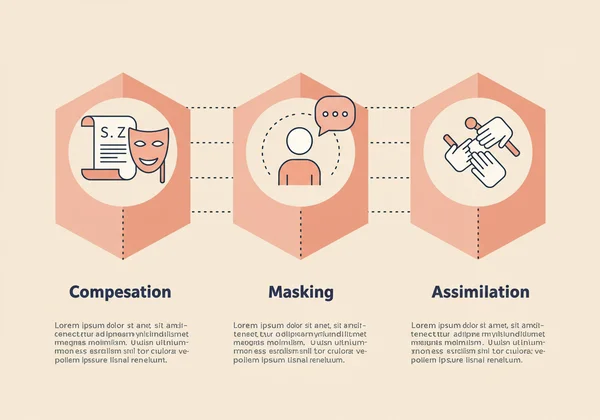CATQ Score Explained: What Your Results Really Mean
Just received your score on the Camouflaging Autistic Traits Questionnaire and wondering what it all means? You're not alone. Many individuals find themselves holding a number, seeking deeper insight into their experiences of autistic camouflaging. But how do I know if I'm masking autism? This guide is designed to help you move beyond the digits and truly understand the nuances of your unique results, offering clarity and validation on your journey to self-discovery.
This journey is deeply personal, and your results are a key piece of the puzzle. They are not a label, but a tool—a mirror reflecting the strategies you may have developed to navigate a neurotypical world. Let's decode what your score is telling you, together.

Demystifying Your CATQ Score Interpretation
Understanding your results begins with understanding the tool itself. The Camouflaging Autistic Traits Questionnaire (CATQ) is a scientifically validated instrument designed to measure the extent to which you may be masking or camouflaging autistic traits in social situations. It provides a quantitative look at behaviors that are often internal and invisible to others.
What is the CATQ Test? A Quick Overview
The questionnaire is a self-report tool developed by Dr. Laura Hull and her colleagues in 2018 as detailed in their foundational research. It consists of 25 questions that assess three core aspects of social camouflaging. It's a vital tool for adults, especially those who suspect they might be on the autism spectrum but don't fit stereotypical portrayals, such as many women and LGBTQ+ individuals. The test helps to give language and structure to the often exhausting experience of "fitting in."
Understanding the CATQ Scoring System
When you complete this assessment, your answers are tallied to produce a total score and three subscale scores. The total score gives a general indication of your overall level of camouflaging. Higher scores suggest a greater use of camouflaging strategies in everyday life. It’s important to remember that this score is a snapshot, not a permanent definition of who you are. To truly understand your profile, it's best to take the online test and see your personal breakdown.
The Three Pillars: Compensation, Masking, and Assimilation Subscales
Your total score is just the beginning. The real insight comes from understanding the three subscales, which reveal your unique camouflaging style. Most people use a mix of these strategies.

- Compensation: This involves developing strategies to overcome perceived difficulties in social situations. Think of it as learning a script. It might mean rehearsing conversations, intentionally using gestures you've seen others use, or developing a "social playbook" to follow. These are your autism compensation strategies.
- Masking: This is the act of hiding autistic traits or pretending to be neurotypical to avoid stigma or negative reactions. This could look like forcing eye contact even when it's uncomfortable, suppressing stimming behaviors (like hand-flapping or rocking), or feigning interest in topics you find overwhelming. It's about hiding your authentic self.
- Assimilation: This refers to the effort to fully integrate into social situations and feel a sense of belonging. It often involves actively trying to mimic others, forcing yourself to socialize even when you're drained, and putting on a persona to be accepted by a group. The core of assimilation is the deep desire not to stand out.
Understanding your scores across this social camouflaging scale helps you see how you camouflage, not just how much.
What a High CATQ Score Might Indicate
Receiving a high score can be a moment of profound validation. For many, it's the first time they have concrete evidence for a feeling they've carried their whole lives—the sense of performing, of being an actor in their own life. It quantifies the immense effort that goes into simply existing in social spaces.
Common Score Ranges and Their Significance
While research provides some benchmarks, it's crucial to view score ranges as general guidelines, not rigid categories. The original research by Hull et al. found that autistic adults scored significantly higher on the CATQ than non-autistic adults, with an average score often cited as being over 100.
However, a "high" or "low" score is less important than what it means for you. A score that might be manageable for one person could be a source of significant distress for another. The context of your life, your support systems, and your mental well-being all play a role in interpreting your scores.
Living with High Camouflaging: The Impact on Well-being
Sustaining a high level of camouflaging comes at a cost. It consumes a tremendous amount of cognitive and emotional energy, which can lead to a state known as autistic burnout. This is more than just feeling tired; it's a state of profound exhaustion that can lead to increased sensory sensitivity, loss of skills, and significant mental health challenges like anxiety and depression.

If your score is high, you may resonate with feeling perpetually exhausted after social events, needing extensive alone time to recover, or feeling like you don't know who you really are beneath the masks. Recognizing this connection is the first step toward finding more sustainable and authentic ways of being.
Navigating the CATQ Cut-Off Score & Its Nuances
Many people ask, "What is the CATQ cut off for autism?" This is an understandable question, as people seek certainty on their journey of self-discovery. However, the concept of a "cut-off" score needs to be approached with care and nuance.
Is There a Definitive Cut-Off? Understanding Research Context
In research settings, cut-off scores are used to help differentiate between groups for statistical purposes. Some studies have suggested a cut-off score around 100 as being indicative of camouflaging at a level common among autistic individuals. However, the CATQ is not a diagnostic tool. It cannot confirm or deny whether you are autistic.
There is no universally agreed-upon diagnostic cut-off. Using a single number to make a determination would overlook the complexity of human experience and the autism spectrum itself. The assessment's accuracy lies in its ability to measure the specific construct of camouflaging, not in diagnosing a neurotype.
Beyond the Numbers: Individual Camouflaging Patterns
Your score is a data point, but you are the expert on your own life. Perhaps you score highly on Compensation but low on Masking. This reveals a specific pattern. The most valuable insights come from exploring these individual camouflaging patterns. Why did you develop these specific strategies? In which situations do you rely on them most? To explore these deeper questions, you can get personalized insights through our optional AI report, which analyzes your unique answers.
Actionable Steps After Understanding Your CATQ Results
Receiving and understanding your results is not the end of the journey; it's a new beginning. It's an invitation to explore your identity with more compassion and curiosity. Here are some constructive ways to move forward.
Reflecting on Your Personal Experience
Take time to sit with your results. How do they align with your lived experience? Think about specific moments in your life—at work, with friends, with family—where you may have used the strategies identified in your scores. Journaling about these experiences can be a powerful way to connect the numbers on the screen to the narrative of your life. This process of self-reflection is key to building authentic self-awareness.
When to Seek Professional Guidance

The questionnaire can be an incredibly helpful tool for self-exploration, but it is not a substitute for a professional evaluation. If you are seeking a formal diagnosis or struggling with your mental health, it is essential to consult with a qualified healthcare professional, such as a psychologist or psychiatrist experienced in adult neurodiversity, perhaps by seeking resources from organizations like The Autistic Self Advocacy Network. Your results can be a valuable starting point for this conversation, providing a framework to discuss your social experiences. This is especially important for those exploring potential undiagnosed autism in adults.
Disclaimer: This article is for informational purposes only and does not constitute medical advice. Please consult a qualified professional for diagnosis and treatment.
Your Journey to Self-Understanding Starts Now
This score, far from being just a number, can be a profound tool for understanding your unique journey. It validates the energy you've spent navigating the world and illuminates the specific ways you've learned to adapt. It gives you a language to describe your experiences and a framework to begin exploring a more authentic way of living.
This knowledge is power. It's the power to unmask when you feel safe, to conserve your energy, and to build a life that honors your true self. If you're ready to take the next step, we invite you to start your CATQ assessment on our secure, private platform. Your journey to clarity and self-acceptance awaits.
Frequently Asked Questions About Your CATQ Scores
What is the CATQ test?
The CATQ (Camouflaging Autistic Traits Questionnaire) is a scientifically validated self-assessment tool used to measure social camouflaging behaviors in adults. It helps quantify strategies like masking, compensation, and assimilation that individuals may use to hide autistic traits and fit into social situations. It is an informational tool for self-exploration, not a diagnostic test.
How accurate is the questionnaire?
The questionnaire has demonstrated good reliability and validity in scientific studies for measuring camouflaging. Its accuracy lies in its ability to consistently measure this specific set of behaviors. When you use our platform, you are using the complete, research-backed questionnaire, ensuring the results are as reliable as possible for a self-report tool.
What is considered a high score?
While there's no official "high score," research indicates that autistic adults tend to score significantly higher than non-autistic adults, often with average scores exceeding 100. A high score suggests a frequent and effortful use of camouflaging strategies, which can be linked to experiences like social exhaustion and autistic burnout.
What is the cut-off score for the assessment?
There is no official diagnostic cut-off score for the assessment. While research studies may use thresholds (like 100) for group analysis, these are not intended for individual diagnosis. The test is designed to provide insight into your personal behaviors and experiences, and the patterns in your subscale scores are often more revealing than the total number.
How do I know if I'm masking autism?
Signs of masking include forcing or faking eye contact, consciously mimicking others' social behaviors, suppressing stims, and feeling completely drained after social interactions. If you consistently feel like you are "performing" or unable to be your true self around others, you may be masking. Taking the free CATQ online test can provide a structured way to quantify these feelings and experiences.